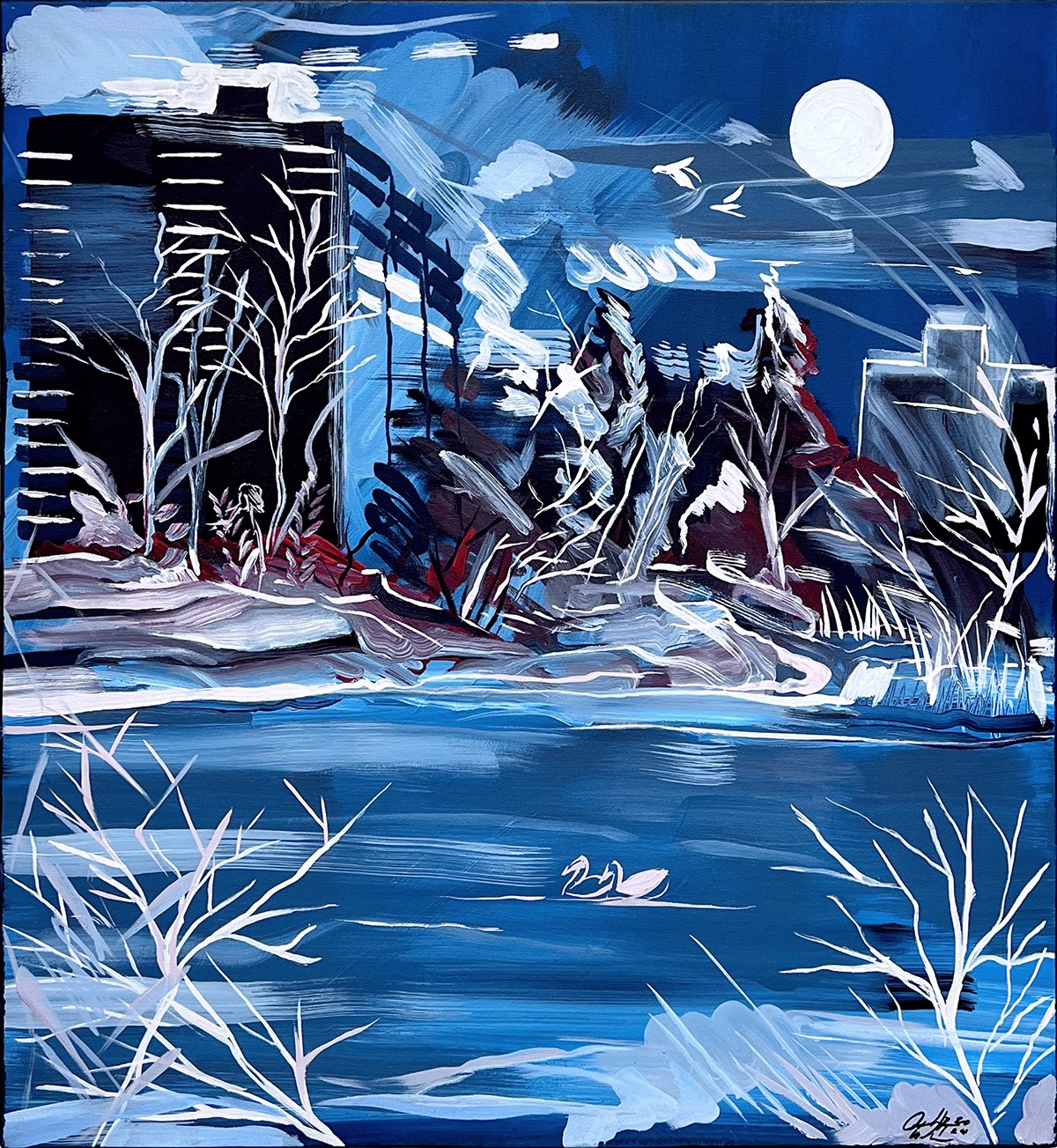Nightwalks
Alexander Richard Wilson: Nightwalks
Dateline
3004 Larimer Street, Denver, CO 80205
April 5-30, 2024
Admission: free
Review by Denise Zubizarreta
As twilight descends upon Denver, Alexander Richard Wilson’s exhibition Nightwalks fills the walls of Dateline with painted homages to a city in transition. Each canvas is a love letter and eulogy to the city’s changing façade, where the historic neon glow now flickers in the shadow of impending modernity.
An installation view of Alexander Richard Wilson’s exhibition Nightwalks at Dateline. Image courtesy of Dateline.
Wilson’s Nightwalks is an introspective journey through Denver at sunset and into the night, encapsulating the beauty of a city that stands at the crossroads of memory and progress. The works capture the city’s essence, veering between the nostalgia of the past and a critique of its march towards a sterilized future.
Alexander Richard Wilson, Esquire, acrylic on linen, 48 x 34 inches. Image by Denise Zubizarreta.
A painting entitled Esquire features the iconic Esquire Theatre, which stands as a sentinel amid the tumult of development. Opened in 1927, this Denver staple represents a bygone era, with its neon sign serving as a beacon of shared experiences and a reminder of the city’s once-intimate charm. Wilson’s painting is a vibrant clash of color and form, where the theater’s neon lights battle against the cacophony of abstract reds and blues that symbolize the encroaching dissonance of “modern living.”
The imminent closure of the Esquire Theatre in July 2024 is not merely the end of an entertainment venue but a symbol of the city’s relentless pivot to “progress.” The theater’s looming transformation into a blend of upscale offices, restaurants, and retail spaces is emblematic of Denver’s metamorphosis. Through the painting on linen, Wilson questions this narrative, hinting at the cost of cultural identity as developers stamp their vision of an antiseptic work-play environment onto the city’s rich historical tapestry.
Alexander Richard Wilson, Dog Walkers At Night, Capitol Hill, acrylic on bed sheet, 36 x 24 inches. Image by Denise Zubizarreta.
In Dog Walkers at Night, Capitol Hill, Wilson channels the vivid palettes of David Hockney and the narrative depth of Roger Brown, inviting a reflection on Denver’s evolving ethos. The painting captures a moonlit tableau where the warm vibrancy of life and the cool detachment of progress intersect. Dog walkers meander through the frame, accompanied only by their shadows and the city’s spectral glow—a stark contrast to the looming, impersonal structures that signify urban development.
Wilson weaves a visual narrative that is both a critique and a celebration, much like Hockney and Brown’s works, articulating the enduring presence of nature amid the city’s sprawl. This piece not only reflects on the starkness of modernization but also resonates with the persistent, often overlooked spirit of the natural world—a silent witness to humanity’s shifting ambitions.
Alexander Richard Wilson, Two Ducks In The Lake at Wash Park, acrylic on linen, 24 x 24 inches. Image courtesy of Dateline.
Nightwalks serves as a powerful commentary on the tensions between the city’s past allure and its future ambitions. The artworks express a profound melancholy for the diminishing spaces where the city’s soul once flourished, spaces now threatened by the relentless march of commodification and uniformity.
Alexander Richard Wilson, 11th and Clarkson, A Girl And Her Dog, acrylic on canvas, 32 x 32 inches. Image courtesy of Dateline.
Conceptually, Wilson invites their audience to reflect on what is lost in the quest for modernization. Their paintings are dialogues between the Denver that was—a community of personal narratives, cultural landmarks, and vibrant nightlife—and the Denver that will be: a landscape dominated by the homogenized aesthetic of economic utility and efficiency.
An installation view of Alexander Richard Wilson’s Esquire and Two Ducks In The Lake at Wash Park. Image courtesy of Dateline.
In essence, Wilson’s Nightwalks is not just an exhibition but a rallying cry—a compelling visual argument that implores us to consider the cost of progress that sacrifices character at the altar of profit. Through these paintings, the viewer walks the streets of Denver not just as an observer of art, but as a participant in the city’s unfolding story, invited to ponder the question: as night falls on the city’s historic landmarks, what will the dawn reveal?
Denise "The Vamp DeVille" Zubizarreta is a multi-disciplinary creative with articles featured in leading arts and culture publications. She earned her BFA in Fine Art from the Rocky Mountain College of Art + Design and is presently pursuing a Masters in Arts Leadership and Cultural Management at Colorado State University.













